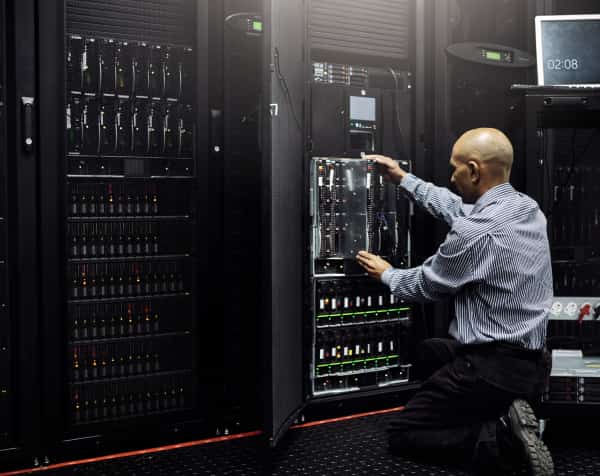IT Support. IT Security. Managed IT Services.
We're Here To Solve Your Technology Problems
Wisconsin Business IT Solutions
- Harness our 20+ years of experience working with hundreds of Wisconsin businesses
- Reduce your expenses with carefully implemented IT, cloud, and security solutions
- Managed IT Services: complete IT management program designed for businesses like yours
How Can We Help?
It’s our job to help your business work faster and more profitably by taking all routine IT tasks off your plate.
Schedule a 15-minute call to see if we are a good fit to help your organization.
"*" indicates required fields
-
“Their consulting work resulted in our working with them for cyber security improvements. Their IT Helpdesk repeatedly saves our company time and money. Their technology planning is second-to-none. Great staff – I highly recommend HPT.”
-
“HawkPoint is our IT Support Team for the company where I work. They are always friendly to me when talking through my issues, quick to respond, and help me get a resolution to my problem. I also appreciate that they don’t mind me asking extra questions about how they helped to resolve my issues.”
HawkPoint provides the solutions your business needs without the hassles and surprise costs, helping you to operate efficiently and minimize security risks.
Certified partner of:






There's a Problem with the Way Most Businesses Approach IT Support
Stop us when this starts to sound familiar...
You’re Working With An IT Provider and You're Not Sure If They're Doing The Best For You...
Many IT providers base their entire business model on reselling software, and not providing any support beyond that.
You're Handling Everything Internally, And It's Becoming A Bigger Job Than It Used To Be...
There comes a point in time when your key team members could better serve the business without also being the IT team.
You're Spending Way Too Much Time Even Thinking About Your IT.
When it should be running smoothly, with a team of business IT experts handling all of your routine tasks.
We're Here To Set The Record Straight...
Having The Right IT Support Partner Can Change Everything

We are innovative problem solvers and experts in technology. We were born in the paper industry and continue to help paper converters, manufacturers, and printers.
However, our client base has expanded to include companies in all industries, including healthcare, legal, agricultural, financial and food manufacturing, just to name a few. While our history is on paper, our future is in IT Services and consulting for all business and all people.
Basically, we're the people that "just make it work". Tell us what you need and we'll take it from there.

Here is how we do it:

Dedicated support and management team
With our team taking care of your technology, you can move on to pursue more lucrative opportunities.
Cybersecurity is included in all of our packages
Say goodbye to unpredictable network outages and unreliable uptime. With our round-the-clock monitoring, you can rest assured that your network will be up and running when you need it most.

Better budgeting with predictable fees
Our cost-effective managed IT services enable you to cut monthly expenses that would have been allocated for resolving technical issues. With these cost-saving solutions, you can be sure that your technology infrastructure will remain reliable and secure, while your budget remains intact.
With the proper level of IT services and support, there's literally nothing your business can't accomplish. That's exactly what we want for you and, at the end of the day, that's what our IT consulting and managed services provider are all about.
Getting started is easy. Give us a call at 920.882.8720 or complete the form, and we will get in touch with you to set up an introductory phone call.
What Happens Next?
- Fill in our quick form
- We’ll schedule an introductory phone call
- We’ll take the time to listen and plan the next steps
"*" indicates required fields
What Makes HawkPoint Technologies Different?
We Take a Personal Approach to IT Support
Predictable Budgeting
We offer managed service plans, retainers, and block rates so you can plan ahead while saving money with no onboarding fees.
IT Expertise
Our team has 20+ years of experience in information technology that will move your business in the right direction to pursue and achieve growth.
Personal Attention
Customer service is our priority. You’ll receive personal attention on projects, implementation, support—we are with you every step of the way.
Industry Designed Software
Our software solution is tailored for the paper industry, making it a perfect fit for a paper business in need of more production visibility and processes.
Fast Response Time
We provide a timely response from our IT support team, consultants, developers, or other team members with a commitment to exceptional results.
Process Engineering Specialists
We make sure to understand your needs and struggles to get your business the solutions it needs. Our team has hands on and many years of experience.

See What HawkPoint Technologies Clients are Saying
-
“Their consulting work resulted in our working with them for cyber security improvements. Their IT Helpdesk repeatedly saves our company time and money. Their technology planning is second-to-none. Great staff – I highly recommend HPT.”
-
“HawkPoint is our IT Support Team for the company where I work. They are always friendly to me when talking through my issues, quick to respond, and help me get a resolution to my problem. I also appreciate that they don’t mind me asking extra questions about how they helped to resolve my issues.”
Avoid the Headache of Managing Your IT Internally
Managed IT
With our managed IT services offering, we plug our complete IT department program into your businesses to take IT completely off of your plate.
At HawkPoint Technologies, we've designed our managed services offerings to give businesses like yours the benefits of having your own in-house IT department—at a fraction of the cost and with none of the headaches that normally come with it.
All of your routine IT tasks—from new employee onboarding, to help desk support to vendor management, backups and disaster recovery—are provided with a fixed, predictable monthly cost.
Learn More About Managed ITIT Projects
Need help with an upcoming project? Let’s work together to get it done on time and on budget.
At HawkPoint Technologies, we understand you need dependable support you can turn to—not someone who you have difficulty even getting on the phone with.
We offer a wide range of project and consulting services for you to choose from, whether you're looking for a major infrastructure upgrade, strategic IT planning or something far smaller in scale, we've got the experience and expertise to help.
Learn More About IT ProjectsFrequently asked questions
Our office hours are 8-5 M-F but we offer support options 24/7/365.
Our goal is a 24-hour response time and one week to resolution. Our current average is 2.5 days to close all requests.
Yes. We have processes for onboarding employees and terminations.
Absolutely. Cybersecurity is one of our specialties. We provide solutions that fit your business and industry and our focus is to keep you secure and productive.
Our help desk can assist your employees with all matters of help desk, including password resets, system updates, hardware issues, connectivity issues, and general inquiries.
Definitely. HawkPoint works 100% in the cloud and we can help you do the same.



